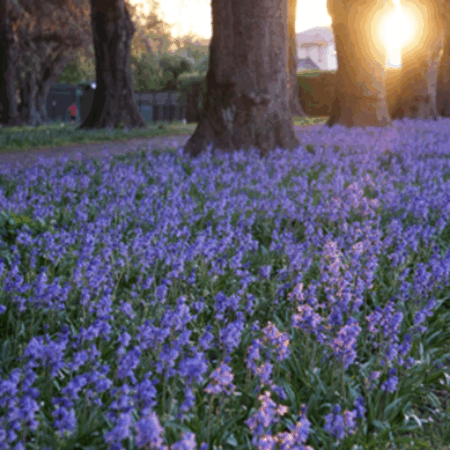It seems to me that the bluebells in St James Park are more numerous and vibrant this year. There under the mature linden trees (also called “common lime tree”) they are the very picture of serene beauty. And they represent something of an old-world charm. We can be grateful at the beauty of God’s creation as spring warms up and nature shows its many colours.
This thankfulness is important, but of course we may also be aware that these flowers are not there by accident, but rather were planted in a place that has been prepared for them. Some find it contentious that these are clearly introduced species: the linden trees are originally from central Europe; the bluebells come from Spain. Both species have been found in British parks and gardens for centuries and have also found their way to New Zealand. And that’s the thing with gardens. For millennia gardens included plants that have been taken out of their natural habitat, bred over generations and planted together with other flora in an array that combines natural beauty with man-made order. That was true of the gardens in ancient Mesopotamia just as the gardens of modern Japan, of the gardens of princes and those of workers, of public gardens and private. Gardening is the working together of humans and God’s creation. And in a long tradition that includes the use of exotic plants.
Last week I was walking in the mountains near Arthur’s Pass. As I was making my way through the New Zealand beech forest, the sun filtered through the trees and glittered on the snow—it was a moment of serene beauty. There was no need of pretty exotic plants here – this was beautiful in its own way. I think we can appreciate both: the natural beauty of the native bush, just as much as the beauty of gardens with flowers from all around the world. Both have their place.
But can they never mix? Well, of course they can. After all, some native plants also do well in gardens (though maybe not cabbage trees if there is a lawn or a flower meadow). I am always fascinated by the Pudding Hill Scenic Reserve near Methven. This is an area of native bush with stands of larch and alder mixed in; near the Awa Awa car park rhododendrons merge into the bush; rata also flower here prominently. In its combination of native and exotic plants it is quite beautiful and has marked seasonal changes. However, I wouldn’t want that to be the picture all through the high country.
I sometimes wonder whether our prayer books reflect the attitudes that are also seen in our gardens and landscapes. After all, the Book of Common Prayer was transplanted to New Zealand, the New Zealand Prayer Book seems to be a joyful merging of native and “imported”, and now there are voices calling for a purer separation between indigenous and “colonial”. For most of us that distinction doesn’t greatly matter; we experience beauty when we see it. And the Gospel? Well, even though it came from the Near East, it has changed cultures throughout history and seeks to

